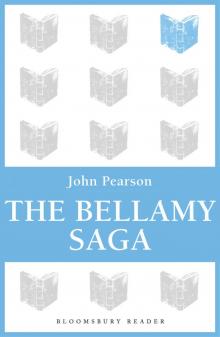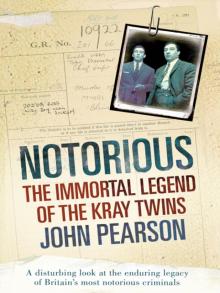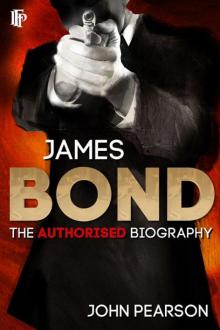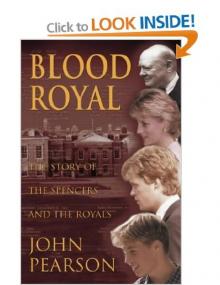- Home
- John Pearson
Blood Royal: The Story of the Spencers and the Royals Page 9
Blood Royal: The Story of the Spencers and the Royals Read online
Page 9
But there was one purchase which gave her particular satisfaction. One of the most spectacular losers in the crash had been the City mogul Sir Theodore Janssen, whose prized estate, Wimbledon Park in Surrey, had also been forfeit because of his role as a director of the Company. Sarah bought it for £25,000, cash down, and obtained one of the great property bargains of the eighteenth century. It included over a thousand acres of well-stocked woodland and farmland, a forty-acre pond, manorial rights over Wimbledon Common, the villages of Putney and Roehampton, the half-demolished ruin of a Tudor mansion and the site of the present All-England Tennis Club, all within five miles of Hyde Park Corner.
Not that she needed the estate or particularly wished to live there. Although she had Holywell, Marlborough House and the use of Blenheim, her favourite residence was still the enchanting Ranger’s Lodge in Windsor Park. But once she had purchased Wimbledon her building mania overtook her and she was soon busily engaged in getting the remains of the Tudor mansion torn down and commissioning the architect Roger Morris, a pupil of the great Lord Burlington, to design her a Palladian villa in its place. Since she was already suffering from the arthritis which would finally cripple her, she made Morris place the piano nobile, normally on the first floor, at ground level, so that she would not have to climb the stairs. She never cared for the result which, as she said, made the house ‘appear to curtsey’, and rarely stayed at Wimbledon herself. She explained that she was building for the future.
Now that she had her great fortune and was busily acquiring what amounted to a private kingdom, Sarah started planning what should be done with it following her death. It meant so much to her that she had no intention of simply leaving this to chance, and just as her fortune had become her greatest source of power, so, with old age approaching, she felt that it could also be her surest hope of immortality.
Had her son Blandford lived, there would have been no problem. All would have gone to him. But the more she saw of Henrietta and her son Willigo (who was now Lord Blandford), the less could she endure the thought of wasting all her hard-won fortune on them. Besides, as Mrs Freeman, she had already realised that were she clever, there remained one further very special male prerogative she could indulge in - that of establishing a dynasty.
It is hard to know how much she originally envisaged this as Mrs Freeman’s answer to the Marlborough dukedom, but certainly her personal dislike of Blenheim Palace influenced her decision. As Duchess Sarah she had played her crucial part in creating that great monument to her husband’s glory, but from the start she had seen the palace as ‘his greatest pride and his greatest weakness’. Then, with all the troubles that ensued, her dislike of Blenheim grew apace, until she saw it as that ‘cruel, unmerciful house’, imbued with the very qualities which she as a true-born Whig detested. Built like a royal palace, Blenheim was steeped in majesty and ostentation, everlastingly proclaiming one man’s overwhelming power and domination. The fact that that man had been her husband made it even less acceptable. She had done her duty by ‘the dear duke’ in ensuring that his house was finished, and when her own time came she would be buried in the chapel there beside him. But none of this would ever make her like it.
The house she really loved was Althorp, which she remembered from its heyday after Shameless Sunderland had made it such a place of beauty, and she and her husband had visited as guests of hospitable Anne Sunderland. She had cherished the memory of it ever since and had come to regard it as a sort of idealised Whig country house. As she put it, ‘there was room in it to entertain a king, if one could have the bad taste to like them, or the company that surrounds them. And yet it was so contriv’d that one might live there mighty comfortably with a few friends.’
It was also the family home of her Spencer grandchildren. Having completely alienated all her living children, these grandchildren offered her a promise for the future, and she knew that, whatever happened, no future duke of Marlborough would ever get his hands on Althorp, or undermine the independence of the House of Spencer.
At the centre of all Sarah’s plans was twenty-year-old Robert Spencer, who, on the death of his father, had become the fourth Earl of Sunderland and taken up residence in Althorp. His brothers, fifteen-year-old Charles and thirteen-year-old John, were still at Eton and their sister Anne was on her marital bed of nails as Lady Bateman, leaving Sarah free to bring up her favourite grandchild, eleven-year-old Diana Spencer. ‘Lady Dye’, as Sarah called her, was a pretty child who reminded Sarah of her daughter, Anne, and Sarah seemed entranced with her, telling everyone that she ‘already has more sense than any body that I know of my sex’.
But Sarah’s real interest was in Robert Spencer, for she was already planning to make this fortunate young man principal heir to all her fortune and her property. Just as Blenheim and the dukedom were her husband’s monument, so she was hoping that with her own inheritance added to the Spencer lands at Althorp she could turn the Spencers into a supremely rich and powerful Whig dynasty, who would stand as her memorial.
Central to her thinking was her hatred of what she saw as the corruption of government produced by the alliance of Sunderland’s successor as prime minister, Sir Robert Walpole, with King George II, through whom he controlled the wealth and patronage of the court. Now that her own courtier days were over, she had come to resent the court and the monarchy with a jealousy and bitterness of which only she was capable, and she seems to have hoped to turn her grandson into a great and incorruptible Whig statesman who might yet defeat her enemies. Backed by her wealth, and fired by her inspiration, he and his descendants would one day vindicate the Whig ideals that she believed in.
Soon she was taking steps to prevent ‘her jewel’ from succumbing to the blandishments of Robert Walpole and the court, who might yet bribe him with a pension and a court appointment. No sooner had Robert come of age and taken his seat in the House of Lords than she offered him a pension of her own of £1,000 a year and told him he would be her heir as long as he never sided with the court, the government or Robert Walpole.
Young Lord Sunderland was perfectly prepared to indulge his interfering but immensely wealthy grandmother. She was in her seventies by now and seemed unlikely to survive much longer. So he did what any sensible and self-indulgent young nobleman would do in such circumstances. He was most charming when he saw her, always agreed with her, flattered her outrageously, then went on living exactly as he wanted. He was a sociable young man and his life consisted chiefly of hunting, gambling, travelling abroad and borrowing heavily against his expectations as he waited to inherit his grandmother’s money.
While he waited, so did Sarah, who was becoming impatient for her charming grandson to marry and produce the all important heirs to her fortune and her property. But even the promise of Wimbledon as a wedding present failed to make him settle down. Six years after his father died Lord Sunderland was still unmarried, and Sarah, one of whose favourite occupations was match-making, was becoming seriously perturbed. Needing a scapegoat, she accused his sister, Lady Bateman, of providing Robert with a mistress especially to flout her wishes.
Wisely, Lord Sunderland refused to argue, and it may well have been to escape from all this talk of marriage that he slipped quietly away to France in the summer of 1729. Out of sight of Sarah’s spies, he was free to indulge in what he most enjoyed - the whirl of Paris and the gambling at Versailles. But early that September came the news that Sarah always dreaded. Robert was back in Paris and had fallen ill with fever.
Practical as ever, she instantly despatched a parcel of medicines, and was about to leave for France herself when she heard it was too late. So many celebrated doctors had been bleeding Robert Sunderland with leeches that, as his fever subsided, so had he. Enfeebled though he was, he was still worrying about his debts, as he makes clear in his final letter to his brother Charles:
‘Dear Brother, I am now a-dying, and therefore desire when I am dead that you will do according to the directions in this letter.’
Listing his debts, he begged Charles to repay them for him - 220 guineas to Sir Michael Newton, £1,128 to Matthew Lamb the moneylender (and future scourge of the Spencers), and ‘Mr Herbert who has a mortgage of £6,300 upon my estate’.
His conscience cleared, Robert Spencer, fourth Earl of Sunderland, closed his eyes and went to meet his maker. Since his dying wish was to be taken back to Althorp and buried with his ancestors in Great Brington church, ‘they sent the corpse in the Calais coach with his former valet, M.D’Olignon, and a footman to attend it’.
Sarah was not present at the funeral, but was soon blaming the French doctors for murdering her grandson, and her grandson for dying. When her anger had receded, she felt deeply sorry for herself. It was, she told Lady Mary Wortley Montagu, ‘the cruellest of blows to have one droop so untimely from the only branch that I can ever hope to receive any comfort from in my own family’.
For Sarah the worst consequence of the untimely death of Robert Sunderland was that it upset her deep-laid plans for the inheritance and forced her to begin again with the new incumbent at Althorp, twenty-three-year-old Charles Spencer, who had overnight become the fifth Earl of Sunderland. Like both his brothers, Charles had been wildly spoiled by the prospect of inheriting from Sarah’s evergrowing fortune. But in contrast with his tactful, if evasive, brother, Charles had not a hope of winning Sarah’s tempestuous affection.
He seems to have irritated her from the start, probably because he looked exactly like his father. In character, too, he was his father to the core - the same abrasiveness and lack of charm, the same ‘large make’, but without the cleverness. The best that Sarah could say for him was ‘they say hee has sence, but hee has nothing at least before me that is entertaining’. Try as she might, she said, she could never bring herself to love him.
Although he had conscientiously settled Robert’s debts, she refused to help him pay them. Once he was settled into Althorp trouble inevitably started - and inevitably over money.
In fact, he seems to have inherited something of the family’s artistic taste, which, combined with his passionate love of horses, now gave Althorp two of its greatest treasures - John Wootton’s near life-size paintings of his favourite horses which still dominate the entrance hall, and the great Palladian stable block for over a hundred horses. This equine palace is something of a masterpiece of Georgian architecture which Professor Nikolaus Pevsner rated higher than the later restoration of Althorp House itself.
But Sarah was outraged when she heard about the stables, partly because of the expense and partly because, contrary to her advice, Charles had employed as architect ‘that infamous fellow’ Roger Morris, the architect responsible for her house at Wimbledon. Inevitably she and Morris had had an angry falling out once the house was built and, intolerant as ever, she could not bear to think of any member of her family disagreeing with her wishes.
All this apart, Sarah was right to be disturbed about her grandson’s expenditure. For, as his brother had before him, Charles was banking everything on Sarah’s fairly imminent demise. Having been brought up, like his brothers, with the prospect of finally inheriting all the money he could ever need, there seemed no reason to worry overmuch about expenditure, and soon he was proving even more extravagant than Robert. Only the strongest willed of heirs could have resisted borrowing against such expectations, and strength of will was not his forte. Charles could hunt and womanise and gamble, but he could only pay for these expensive pleasures by mortgaging his future with moneylenders such as Matthew Lamb, at quite extortionate rates of interest.
It was now that Sarah’s great plans for the future started going wrong, due largely to her own behaviour. For clearly there was a fearsome downside to the courageous, freedom-loving woman riding like a fury through the storms of eighteenth century politics. She could also be vindictive, manipulative, obsessively suspicious and totally insensitive to other peoples’ feelings. And since she would ultimately depend upon her family to achieve what had become her life’s ambition, it was through feuding with its members that she put at risk everything she wanted.
The first sign of trouble came when, irritated by her grandson Charles, she began to show unusual interest in his cousin, the Duke of Marlborough’s previously neglected heir, Willigo, Lord Bland-ford. Having become a Jacobite, a Catholic convert and an alcoholic, Blandford was not exactly ducal timber and since his sexual tastes inclined him to stable-boys, few expected him to marry. But in 1729, during one of the lengthy European tours that he indulged in, marry he did - to the daughter of a rich Dutch burgomaster called de Jong. The former Miss de Jong was not the type that Sarah would normally have embraced as a potential Duchess of Marlborough, but when, in 1730, Willigo brought her back to England, Sarah, to everyone’s surprise, welcomed the couple effusively, expressing fond affection for Lord Blandford and saying how much she hoped the couple would soon start a family. Sarah knew quite well that news of this would get back to Charles Sunderland at Althorp, and presumably felt that it would do no harm to remind him of potential competition in his hopes for the great inheritance.
So far, Sarah’s behaviour was relatively harmless. More serious was the vendetta which was growing up between her and her eldest granddaughter, Lady Bateman. Another enemy within the family was the last thing Sarah needed, but she could not resist the temptation to upset poor Anne Bateman when they were together, and since Anne had inherited every ounce of Sarah’s own vindictiveness, trouble loomed between them.
Where Sarah now appears at her meddling worst is over her marriage plans for the one member of the family she really loved – her youngest Spencer granddaughter, ‘Lady Dye’. Sarah had already paid an expensive London doctor to cure Diana of scrofula, and was determined to find her a rich husband when, according to Robert Walpole’s son, the diarist Horace Walpole, Sarah hit upon a plan of breathtaking presumption. The Hanoverians had a habit of feuding with their offspring, and at the centre of the opposition to King George and Queen Caroline stood their own disaffected son and heir, Frederick, Prince of Wales. The Queen herself described her son as ‘the greatest ass and the greatest canaille and the greatest beast in the whole world, and I heartily wish he was out if it’.
Frederick felt much the same about his parents and, according to Horace Walpole, Sarah found irresistible the idea of scoring the ultimate victory over the court and the Royal Family itself by capturing the Prince of Wales as a husband for Diana. Knowing that he was always short of money, she supposedly offered him a dowry of £100,000 and he accepted.
If this was true - and in fairness to Sarah it must be said that the only account of this comes from Horace Walpole - it seems unforgivable that, in order to score off Queen Caroline and George II, Sarah was perfectly prepared to sacrifice the happiness of her own beloved Diana Spencer, by marrying her to that ‘cad and cur’, the Prince of Wales.
Fortunately for Diana, little escaped the notice of wily Robert Walpole, and, hearing rumours of what was happening, he promptly put an end to Sarah’s plans for the secret marriage. Diana was well out of it and showed no sign of sadness or regret when, soon afterwards, she married Lord John Russell, the plump brother of the Duke of Bedford.
No sooner had Sarah married off Diana than death stepped in to rearrange the succession of the Spencers. Poor Willigo Godolphin had not managed to stay sober long enough to father an heir, and in August 1731, during an all-night feast at Balliol College Oxford, he drank so much that he suffered an attack of delirium tremens from which he never surfaced. Sarah was deeply shaken by his sudden death, and for once picked on the right person to blame for what had happened when she muttered that she ‘hoped the devil is picking the bones of the man who taught him to drink’.
Willigo’s estranged mother, Henrietta, was still Duchess of Marlborough in her own right, but Charles Sunderland was now inescapably her heir. He would succeed to the dukedom on her death, and not even Sarah Marlborough could prevent it. Nor could she affect the succession to Altho
rp, which was governed by the terms of her husband’s will, in which it was clearly stated that if a Spencer became the heir to the Duke of Marlborough, Althorp and the family possessions would pass unencumbered to the next in line among the Spencers.
Now that the Spencer family between them had become the exclusive heirs of the fortunes and honours of the Marlboroughs, this if ever was the moment for Sarah to have made her peace with all the grandchildren, Charles included, and even with embittered Lady Bateman. But reconciliation was not in Sarah’s nature, any more than it was in Charles’s, and with his prospects suddenly enhanced to the tune of £8,000 a year from the Marlborough trust, which had previously gone to cousin Blandford, all his old resentments rose against her. Soon he was heard boasting in his cups that the money would free him from dependence on ‘that unloving, capricious, extravagant old fury of a grandmother’. A few more drinks and he was promising ‘to kick the old fury’s A- … and make her kiss his own’, words which inevitably got back to Sarah, who, surprisingly, kept her counsel and did nothing.
But not for long. Soon there was further news from Charles that set Mount Etna into full eruption: the ungrateful wretch who had just become heir to her own dear Duke of Marlborough had decided to get married, and without consulting her. Worse still, the shameless hussy who would one day bear the title of Duchess of Marlborough was none other than Elizabeth Trevor, daughter of the unmentionable Lord Trevor, one of twelve servile Tory peers who had been created to ensure the passage through the House of Lords of the infamous Peace of Utrecht, which had brought such suffering and shame on her late husband.
Then, as if all this were not enough, every one of her Spencer grandchildren, apart from ever faithful ‘Lady Dye’, had used the occasion to defy her by attending Charles’s wedding, to which, of course, she was not invited. Sarah was convinced that the ringleader had to be the woman who was now her greatest enemy, her own granddaughter, evil Lady Bateman.

 The Bellamy Saga
The Bellamy Saga Notorious: The Immortal Legend of the Kray Twins
Notorious: The Immortal Legend of the Kray Twins Learn Me Good
Learn Me Good James Bond: The Authorised Biography
James Bond: The Authorised Biography Painfully Rich
Painfully Rich The Profession of Violence
The Profession of Violence Biggles
Biggles Blood Royal: The Story of the Spencers and the Royals
Blood Royal: The Story of the Spencers and the Royals